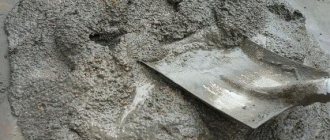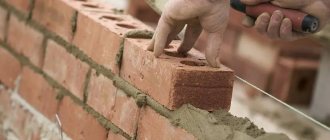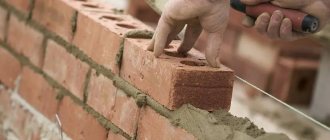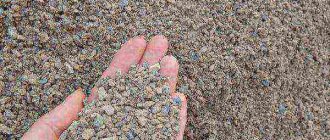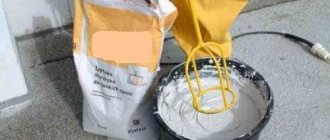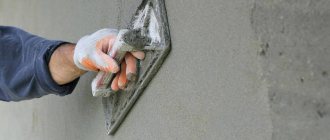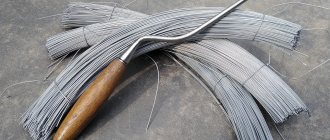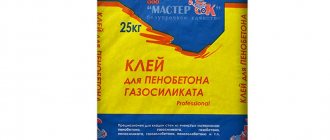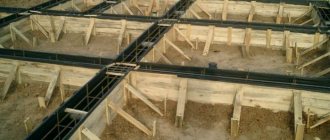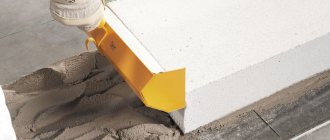Builders constantly calculate the required volume of sand when performing a wide range of work:
- backfilling and raising areas;
- construction of foundations and fences;
- screed formation;
- pouring the blind area;
- preparing concrete;
- improvement of territories.
Accurate calculation of the required volume of sand saves time and money.
In most cases, quarry or river sand is used for construction purposes. The specific gravity of 1 m³ of quarry sand is 1,500 kg, river sand is 1,630 kg.
River sand is heavier, which is explained by the smaller grain size and higher density of the material. It is recommended to purchase sand in dry weather, when it contains a minimum of excess moisture.
Current SNiP or old-fashioned method
The current rules give a fairly clear answer to the question of how much cement per cube of mortar may be needed. At the same time, calculations usually take into account not only the optimal volumes of components, but also their characteristics: fraction, purity, humidity, density, quality, etc.
When studying the norms of material consumption per cube of concrete, you should also take into account the conditions in which you plan to carry out the work. Thus, SNiP assume that concrete mixing and work are carried out at an ambient temperature of +23 degrees, under conditions of average humidity levels. All components must be clean and have a maximum moisture content of 7%.
In the tables you can find the following data:
When preparing concrete, it is important to calculate how much crushed stone and sand is needed per 1 m3 of solution, since the strength, reliability, durability of the monolith and other important characteristics depend on these components.
The table shows the consumption of sand and crushed stone:
When preparing concrete, you should remember that everything can be calculated based on the total weight of a cubic meter of solution. But that's not true. Given that the cement is extremely finely ground and fills the voids between the sand grains, it may not increase the overall volume of concrete. So, by adding 200 or 400 kilograms of cement, the volume of solution (1 cubic meter) is obtained the same.
Water is added to the mixture in an amount equal to half the mass (but not volume) of cement. The moisture content of the sand must be taken into account - the wetter the sand, the less water will be needed. It is best to pour water in portions and look at the consistency: when it reaches the required thickness, the concrete will be ready for use.
Regardless of the brand of concrete, its consistency should be optimal for the job. According to the standards, consistency is determined by the amount of sediment of a metal cone, which is dipped into the solution.
Calculation options
To find out exactly how many tons of sand are in 1 m3, laboratory tests are carried out using special measuring containers. A cylindrical vessel is filled to the brim without compacting the contents, then weighed and calculated using the formula:
p = m: V, where m is the mass of the filled container, V is the occupied volume, p is the specific gravity.
The results are recorded in a passport or quality certificate, which the supplier is obliged to provide at the buyer’s request. But at home, when the material has already been purchased, but its characteristics are unknown, similar calculations can be made. Take a 10-liter bucket, carefully fill it with sand and weigh it. If it weighs, for example, almost 17 kg, convert the resulting value into tons and substitute the data into the formula:
0.017 t: 0.01 l = 17 t/cubic. m
Remember that the bucket also has mass. For accurate calculations, it should be subtracted from the total weight. Check the obtained data with the table. They approximately correspond to the specific gravity of compacted construction sand. It is used when arranging the foundation, backfilling, paving paths, etc.
Compacted sand is on average 15% heavier than loosened sand. And wet building materials are 20–25% heavier than dry ones. If you have sand stored on your property that is not covered and has been exposed to rain repeatedly, it will be very massive. A filled 12 liter bucket will weigh at least 30 kg (0.03 tons). Accordingly, the weight of a cubic meter will be:
0.03 t: 0.012 l = 2.5 t/cubic. m
This material is not suitable for the production of building mixtures. To prepare cement mortar with it, you must first dry and loosen the sand. Otherwise, it is impossible to maintain the required proportions, and the consumption of bulk material will almost double.
Save your time and avoid complex calculations - use the calculator for converting sand from tons to m3. It is posted on the website and is available for free. Calculations are made taking into account the characteristics of bulk materials presented in our catalog. Indicate their type and origin to calculate how many tons are in a cubic meter of sand.
In our company you can buy sand with delivery throughout Moscow and the Central Federal District; to place an order, call the numbers listed on the website.
What determines cement consumption?
The amount of cement used per cubic meter of solution depends on the powder used and its properties, as well as the technical characteristics that the concrete must meet. The proportions can vary quite a lot; in the preparation of different grades of concrete, different volumes of cement, sand, crushed stone, and water are used. Additionally, the exact values vary depending on several factors.
Factors influencing cement consumption per 1m3:
- The volume of fillers in the solution - the more sand and crushed stone, the more kg of cement, which acts as a binding component and holds the filler particles together. The optimal ratio of bulk mixtures is calculated based on the amount of cement.
- The brand of cement that is used in mixing concrete - as the number increases, the strength of the structure/building being created increases. The grade of the final mixture is 1.5-2 times lower than the grade of cement, because the composition also includes gravel/crushed stone/slag and sand.
- The required grade of mortar that needs to be prepared - not only cement, but also concrete is divided into grades, each of which has certain characteristics and parameters. Only after determining the grade of concrete can you understand how much cement is needed per 1 cubic meter. So, for example, to obtain an M100 mixture using M500 cement, you need to mix part of the binder, 5.8 parts of sand, 8.1 parts of crushed stone. But to obtain an M450 solution, the proportion looks like this: 1/1.4/2.9.
- The density of cement also plays an important role. The indicator depends on the brand of cement, the average is 1300 kg/m3.
Thus, the consumption of cement, sand, and crushed stone directly depends on the brand of cement (used in the batch) and the brand of concrete that needs to be obtained in the end.
Types of cement
Portland cement is the most popular in construction. To make it, natural raw materials are fired, and then the resulting cement clinker is finely ground.
Adding a small amount of gypsum (about 5%), slag and rocks (up to 10-15%) makes it possible to reduce the cost of Portland cement without significantly affecting its technical characteristics. But if the cement is intended for the construction of road surfaces with a high degree of frost resistance, only gypsum is added.
Portland cement is used to create critical structures and foundations subject to high loads. In addition, a number of cements with specific characteristics made on its basis are used in construction. This is Portland cement:
- with hydraulic additives;
- hydrophobic;
- plasticized;
- slag
There is also alumina cement, which quickly hardens in water and is resistant to aggressive environments - used for emergency work. For mortars and concrete of low strength grades, the use of mixed cements is allowed - in addition to cement clinker, their composition includes various mineral additives and binders (slag, lime) in large quantities.
Depending on the pressure indicator (kg/cm3) during compression of the concrete sample, the cement strength grade was determined - from 100 to 600. Today, a strength class is assigned from 22.5 to 52.5 (in accordance with the sustained pressure, measured in MPa).
When preparing cement-sand mortar for brickwork, take into account that the construction of 1 m2 of a wall with a thickness of 1 brick (250 mm) will require at least 75 liters of M100 grade mortar. The proportion of cement (M400) - sand here is 1:4. Cement consumption for bricklaying with this ratio will be 250 kg per 1 cubic meter of sand.
Water, as we have already said, is taken at the rate of 1/2 of the total weight of the cement used.
Translating into “bucket standards” that everyone can understand, let’s say that for one 10-liter bucket of cement (M500) we need four buckets of sand and 7 liters of water. We calculate the amount of water based on the weight of the cement in the bucket (10 liters x 1.4 kg x 0.5 = 7 liters).
Types and brands of mixtures
The grade of cement and concrete are two different indicators. M400 grade cement can produce concrete of different grades, which depends on the kilogram of cement per 1 m3 and the volume of fillers. As a rule, to prepare a solution of a certain grade, use cement grade 1.5-2 higher.
The brand of cement is indicated on the packaging in the marking - indicated by the letter M and numbers. The grade is a direct indicator of the strength of the material. In mortar, the strength depends on the brand and volume of cement used. The higher the grade of concrete, the more difficult it is to work with, but the strength will also be higher, as will other performance characteristics.
Where different grades of concrete are used:
- M100 – implementation of the preparatory stage of various works (concrete is often placed in a thin layer on a sand bed under the foundation)
- M150 – foundation for small buildings, screeding and pouring the base as a rough layer, concreting paths
- M200 – pouring garden paths, foundations, blind areas, concrete screeds in garages and residential premises
- M250/M300 – creation of a monolithic foundation, stairs, fences, supports, medium-load floor slabs, blind areas
- M350 – pouring critical structures (floor slabs, monolithic foundations, columns, crossbars, swimming pool bowls, etc.)
- M400 – construction of cash vaults, bridges, hydraulic structures, objects with special requirements
- M450/M500/M550 – the same targets as the M400 brand, also dams, dikes, subways
- M600 - used in the construction of objects that require special resistance to aggressive factors that require maximum strength (reinforced concrete bridges, special-purpose structures, hydraulic-technical objects, etc.).
Consumption rates for different solutions
Depending on what concrete is needed for, 1 m3 of solution may contain different volumes of cement. In modern construction, concrete mortar is used to carry out four tasks: pouring the foundation, laying building blocks, pouring screed and performing plaster. For each of these types of work, it is assumed that a certain type of mortar with a specified volume of cement will be prepared.
The highest consumption of cement per cube of mortar is obtained when preparing a mixture for masonry or plaster. When pouring a foundation or screed, it is important to use large fillers (gravel, crushed stone, slag), which reduces cement consumption. The purpose of the solution is indicated by the brand (the properties of concrete and the main characteristics depend on it).
Calculation of cement per cube of concrete according to GOST:
- M100 – 170 kilograms of cement
- M150 – 200 kilograms
- M200 – 240 kilograms
- M250 – 300 kilograms
- M300 – 350 kilograms
- M400 – 400 kilograms
- M500 – 450 kilograms
For plaster
A standard plaster solution is prepared from 3 parts sand and 1 part cement. If the layer is made with a thickness of no more than 12 millimeters, then 1.6 kilograms of M400 cement and 1.4 kilograms of M500 cement are weighed per 1 square meter of plaster. The volume of mortar per cubic meter of masonry can be calculated as follows: 1 m2 x 0.012 m = 0.012 m2 = 12 liters.
On masonry
For a square meter of brickwork one brick thick, you will need at least 75 liters of M100 mortar. The proportion of M400 cement and sand is 1:4. Thus, the cement consumption for bricklaying is 250 kilograms per cubic meter of sand. How many cubic meters of solution will be needed in total is calculated based on the size of the building.
For the foundation
To prepare a solution for pouring the foundation, you need to calculate everything correctly. Typically, a solution of grade M100-M300 is used. The strength of M100 is sufficient for low-rise buildings, M150 and M200 are suitable for buildings of several floors. The higher the grade, the stronger the structure will be. For mixing, take cement M300/M400 (1 part binder and 3 parts sand) or M500 (1 part binder and 5 sand).
How to calculate the amount of sand per area
To calculate the required volume of sand per area (for example, for a sandbox or for backfilling), you need to multiply the area (in square meters) that needs to be covered with sand by the height of the backfill. For example, to calculate the required amount of sand for an area of 200 m2 at a height of 30 centimeters, the following operation is carried out: 200 m2 * 0.3 m = 60 m3
In addition, it is necessary to take into account the compaction coefficient; it varies for different types of sand, usually this figure ranges from 5 to 30 percent. Therefore, the volume of materials required usually needs to be multiplied by at least 1.1. That is, in this example, at least 66 cubic meters of sand will be required.
How many bags of cement to buy
To understand how many bags of cement will be needed to prepare the mixture, use proportions and volume. So, if you prepare a batch for floor screed and use a ratio of 1:4, it turns out that you need a quarter of a cube of cement. The bulk density of the binder shows that a liter contains 1.4 kilograms.
Binder consumption can be calculated differently. So, if the thickness of the screed is 10 centimeters, then for one square you need 0.1 cubic meter of solution. It contains 10 times less cement than a cube: 350 kg / 10 = 35 kilograms. For a screed 5 centimeters thick you need 35 / 2 = 17.5 kilograms of cement.
It is worth remembering that the rate of cement consumption also depends on the activity of the binder. It is usually determined experimentally, during the process of mixing control samples, and during strength testing. But this cannot be done on site, so you should focus on the shelf life of the material. The fresher the better, since over time cement can lose up to 20% of its activity per month. After keeping bags of M500 cement in the warehouse for about three months, you can already work with the M400 brand.
Concrete prepared using technology and with the correct consumption of cement is able to withstand all loads, demonstrate optimal parameters and properties, guaranteeing the durability and reliability of structures.
How to calculate volume formula?
1) Volume
of a cylinder is equal to the product of the area of the base and the height.
2) The volume
of the cylinder is equal to the product of pi (3.1415) by the square of the radius of the base and the height.
Interesting materials:
How to use a decoction of onion peels in the garden? How to use an HDMI USB adapter? How to use tile adhesive? How to use a plunger syringe? How to use Raptor with liquid? How to use sapropel in the garden? How to use baking soda in the garden? How to use chlorine tablets for a swimming pool? How to use a corner in a room? How to use a drive-in anchor?
How much sand and cement in 1 m3 of foundation mortar
Cement makes the material durable and resistant to stress; compared to sand, its particles are much smaller in size; thanks to this property, it holds together all the components of the manufactured composition and prevents it from crumbling after drying. The consumption of cement per cube of mortar depends entirely on the purpose of its use. For example, a foundation will require a larger amount of binder than brick laying.
- What affects consumption?
- Features of preparing masonry mortar
- Calculation rules
What does consumption depend on?
In order for the base, screed or other structure to be strong and durable, you need to correctly calculate and knead the mixture. Some builders, due to inexperience, may pour too much cement per cubic meter, believing that this will make the structure as strong and monolithic as possible. But eventually, after drying, the solution will begin to crumble and crumble. Cement is the most expensive component, therefore, due to an increase in its volume, monetary costs also increase unjustifiably.
The consumption of Portland cement is affected by the amount of fillers - sand and crushed stone. They are the ones who influence the volume. Cement particles are very small in size, so when it is added it does not increase the amount of composition, since it is evenly distributed in the gaps between the grains of sand and crushed stone. The optimal proportion is considered to be three parts of Portland cement in one cubic meter of solution. The ratio may vary depending on the brand of binder and its shelf life. More information about the composition and characteristics of solutions can be found in the article on the ratios of components per cubic meter of concrete.
To build structures that will withstand heavy loads, a composition of increased strength is required. These include concrete grades from M300. To create screed or plastering, M100 or M150 is sufficient. To make cinder concrete blocks, you can use M50.
Mixture for bricklaying and how to calculate the number of bags per cube of mortar
For mixing, you do not need a large filler, since its task is to reliably fasten the bricks together, because of this, the consumption of sand and cement increases. To determine the size of the proportions of all components, it should be taken into account that there is one cube of sand in 1 m3. Cement does not increase this volume, since it is evenly distributed between the grains of sand.
A standard ratio of 1:3 or 1:4 is used, that is, to make one cube you will need 0.33 or 0.25 m3 of Portland cement. When determining the total amount of composition, take into account that for 4-5 m3 of brick wall, 1 m3 of mixture is taken.
To find out how many bags of cement to buy for one cube of mortar, use the following calculations:
- If components are used for mixing in proportions of 1:4, then 4 parts of sand are added to 1 part of Portland cement, which means that in 1 cubic meter there will be 250 liters of binder powder, and the rest of the volume will be filled.
- To convert cubic meters to kilograms, you need to know the bulk density of the material. For cement it is about 1.4 kg/l; 250 liters will contain 350 kg of binder - 1.4*250=350 kg.
- Portland cement is most often purchased in 50 kg bags, which means in this case 350/50 = 7 bags are purchased. But since any building material must be taken with a reserve, it is recommended to buy 8 bags or 7 of 50 kg and one of 25 kg.
Calculations for screeds, foundations and mixtures of different brands
To find out how many cubic meters of screed solution you need, you should calculate its volume. To do this, multiply the width by the height and length. So, for example, if a screed measuring 6x6x0.05 m is being installed, then its volume is equal to: 6*6*0.05=1.8 m3. That is, this is exactly the amount of solution that will be needed to make it. To create screeds, the components are mixed in proportions of 1:3. Cement will account for a third of the total volume. If it is necessary to mix 1.8 m3, then 1.8/3 = 0.6 m3 of Portland cement is added. Since one cube contains 1400 kg of cement, 0.6 m3 contains 1400 * 0.6 = 840 kg. This means that to build a screed measuring 6x6 and 5 cm thick, you will need to purchase at least 17 bags of binding powder - 840/50 = 17.
To calculate the construction of a foundation or screeds, you can use the indicators specified in SNiP. According to them, when using Portland cement M500 for flooring, you will need 460 kg per 1 m3, M400 - 575 kg per cubic meter. It is necessary to strictly observe the proportions of the components; even a slight deviation to the side can lead to serious consequences: under the load from the weight of the house, the weak foundation will begin to crack.
If cement is used that has previously been unpacked and stored for more than two months, its proportion for any composition is increased. The strength of Portland cement decreases over time due to the fact that it reacts with moisture from the air. Therefore, to calculate proportions, the brand is underestimated by exactly 100. That is, whether the cement was M500, then due to long-term storage it will have to be considered as M400.
The brand of binder powder is selected based on the planned load and operating conditions. Once it is determined, the amount of cement for mixing the concrete mixture is calculated. Its volume directly depends on the required strength of the structure. If you need M50 grade concrete, then for one meter of cubic mortar you will need 310 kg of M300 or 230 kg of M400; for the production of M100 you can already use 250 kg of M500 binder powder, M200 - 355 kg of M500.
The higher the strength grade of Portland cement, the smaller the amount required for mixing the solution, since it has better technical characteristics.
Screed arrangement
About 1.4 kg of dry cement is consumed per 1 liter
In most cases, the composition is prepared according to the principle identical to the previous version. But professionals additionally use plasticizers that improve the performance properties of the mixture, as well as polypropylene fiber. Such components will allow you to obtain a high-quality coating that can last for decades.
| Cement consumption, kg per 1 m³ of sand or mortar | ||||||
| Cement brand | Brand of solution | |||||
| 150 | 100 | 75 | 50 | 25 | 10 | |
| 400 | 350 | 255 | 100 | 140 | — | — |
| 400 | 300 | 240 | 175 | — | — | |
| 300 | 470 | 340 | 270 | 185 | 105 | — |
| 510 | 385 | 310 | 225 | 135 | — | |
| 200 | — | — | 405 | 280 | 155 | 25 |
| — | — | 445 | 325 | 190 | 95 | |
| Note: the top line is cement consumption per 1 m³ of sand, the bottom line is per 1 m³ of solution | ||||||
When preparing a solution, the best option is a hardener of the M150, M200, M300, M400 brands. The consumption of cement and sand for screed is represented by the ratio 1:3. Simply put, for 50 kg of the latter, take 15-16 kg of hardener.
How much sand, crushed stone and cement are in a cube of concrete?
Builders can calculate the consumption of materials per 1 m3 of concrete M200 or another grade using specially created proportions. The ratio is influenced by the quality of the initial components, the strength of the structure specified by the engineering plan and its operational needs. Independently making deviations in the parameters specified by GOST per cubic meter of concrete solution is unsafe and is fraught with premature destruction of the structure.
Concrete mix composition
Builders have identified a standard list of concrete mortar components for a foundation or other purpose. It contains cement of the appropriate grade, a given mass of medium-ground crushed stone, a compactor in the form of sand and a certain volume of water that is required. If necessary, chemical-based components are added. These include plasticizers or frost-resistant additives. It is recommended to regulate the amount of other ingredients.
Standards and requirements for concrete are specified in GOST 27006-86.
Calculation of quantity per 1 cubic meter
Consumption per 1 m3 of concrete is calculated from the proportion of the main components. Based on the required quantity, the solution is mixed from individual ingredients or based on a sand-gravel mixture. According to the standard, the ratio of cement, sand grains, gravel and liquid is 1: 2: 4: 0.5. The quantitative consumption of cement per 1 m3 of concrete or other ingredients varies depending on the quality of the selected initial mixture products. According to the builders, the weight of the finished cube of the mixture is 1.5-1.8 tons. You can find out the exact weight for planning transportation and time for mixing by calculating how many square meters of the building need to be poured.
There are certain proportions for the components of the mixture that make it possible to produce high-quality material.
Cement component
The amount of cement affects the strength of the finished product. The choice of brand depends on the future loads of the finished structure. Being a substance with astringent properties, the number of bags of cement is strictly regulated. As the brand increases, the quantitative value decreases. It is not recommended to change the ratio specified by the manufacturer without permission. The weight of one cubic meter of the finished mixture depends on the rate of cement consumption for preparation. A well-selected component guarantees the durability of the structure and the absence of cracks on the surface.
The amount of material depends on its brand and the purpose of the finished product.
Crushed stone or gravel
The correct consistency and compliance with the parameters is achieved by the addition of solid particles. Builders use gravel or its analogue - crushed stone. The recommended size of crushed stone grains is up to 70 mm. Fractions are designed to fill small air clots in concrete. The amount of crushed stone in 1 cube depends on kg of cement. On average, it accounts for up to 20 percent of the weight of all dry components. The ratio of sand and crushed stone in concrete also correlates with the size of the fractions. As a rule, the latter is 1.5-2 times more sand grains.
Sand as a sealant
Small particles are designed to fill the voids between crushed stone or gravel. The result is a natural sealant. In a cubic meter of concrete, the ratio of sand and cement is 1:2. If there is a need for a batch with special characteristics, the proportion changes and the number of particles in the composition increases. Changes require careful calculation of the amount per square meter of construction or per cubic meter of liquid mixture.
Liquid for mixing
The consumption rate of concrete M300 or M200 directly depends on the consistency. The quantitative standard is set by the property of the finished solution - plasticity. A specified number of liters of water are used to stir and combine the dry ingredients. On average, it takes twice as much cement. Process water cannot be used because it contains impurities. The liquid is added at the end in small parts, adjusting the fluidity. Builders warn: too much water leads to inconvenience during work and loss of concrete quality.
How much sand, crushed stone and cement are in a cube of concrete?
Builders can calculate the consumption of materials per 1 m3 of concrete M200 or another grade using specially created proportions. The ratio is influenced by the quality of the initial components, the strength of the structure specified by the engineering plan and its operational needs. Independently making deviations in the parameters specified by GOST per cubic meter of concrete solution is unsafe and is fraught with premature destruction of the structure.
Concrete mix composition
Builders have identified a standard list of concrete mortar components for a foundation or other purpose. It contains cement of the appropriate grade, a given mass of medium-ground crushed stone, a compactor in the form of sand and a certain volume of water that is required. If necessary, chemical-based components are added. These include plasticizers or frost-resistant additives. It is recommended to regulate the amount of other ingredients.
Standards and requirements for concrete are specified in GOST 27006-86.
Calculation of quantity per 1 cubic meter
Consumption per 1 m3 of concrete is calculated from the proportion of the main components. Based on the required quantity, the solution is mixed from individual ingredients or based on a sand-gravel mixture. According to the standard, the ratio of cement, sand grains, gravel and liquid is 1: 2: 4: 0.5. The quantitative consumption of cement per 1 m3 of concrete or other ingredients varies depending on the quality of the selected initial mixture products. According to the builders, the weight of the finished cube of the mixture is 1.5-1.8 tons. You can find out the exact weight for planning transportation and time for mixing by calculating how many square meters of the building need to be poured.
There are certain proportions for the components of the mixture that make it possible to produce high-quality material.
Cement component
The amount of cement affects the strength of the finished product. The choice of brand depends on the future loads of the finished structure. Being a substance with astringent properties, the number of bags of cement is strictly regulated. As the brand increases, the quantitative value decreases. It is not recommended to change the ratio specified by the manufacturer without permission. The weight of one cubic meter of the finished mixture depends on the rate of cement consumption for preparation. A well-selected component guarantees the durability of the structure and the absence of cracks on the surface.
The amount of material depends on its brand and the purpose of the finished product.
Crushed stone or gravel
The correct consistency and compliance with the parameters is achieved by the addition of solid particles. Builders use gravel or its analogue - crushed stone. The recommended size of crushed stone grains is up to 70 mm. Fractions are designed to fill small air clots in concrete. The amount of crushed stone in 1 cube depends on kg of cement. On average, it accounts for up to 20 percent of the weight of all dry components. The ratio of sand and crushed stone in concrete also correlates with the size of the fractions. As a rule, the latter is 1.5-2 times more sand grains.
Cement consumption rate per cubic meter of solution
| Brand of solution | Recommended brand of binder | Cement consumption per “cubic meter” of solution, kg |
| M200 | M500 | 415 |
| M400 | 480 | |
| M150 | M500 | 345 |
| M400 | 400 | |
| M300 | 490 | |
| M100 | M500 | 275 |
| M400 | 325 | |
| M300 | 395 | |
| M75 | M500 | 220 |
| M400 | 265 | |
| M300 | 335 | |
| M200 | 445 | |
| M50 | M400 | 200 |
| M300 | 250 | |
| M200 | 345 | |
| M25 | M300 | 155 |
| M200 | 215 |
Scope of application of different brands of solution
The rate of cement consumption per 1 m3 of solution will be incomplete if you do not inform readers for what purposes a solution of a particular brand can be used:
- Brand M25. Mixed (complex) mortar for masonry building structures;
- Brand M50. A popular mixed complex mortar for laying bricks (other types of “stone materials”) and arranging reinforced (“mesh”) floor screed;
- Brand M75. It is used for: stone and brick masonry, production of vibro-brick structures, installation of floor screeds of small thickness, installation of lintels (no more than 2 meters long), arrangement of underground communications, construction of structural elements of heavily loaded premises of production workshops;
- Brand M100. Application – construction, masonry and plastering work of all types, as well as filling horizontal and vertical joints of panel structures;
- Brand M150. It is used for masonry and plastering work, finishing hydraulic structures, laying ceramic tiles, arranging a finishing screed, and also for filling the seams of panel walls. In addition, M150 mortar can be used to fill the foundations of buildings located on “weak” and wet soils;
- Brand M200. It is used for installation of vibrating brick panels, filling joints, plastering work, waterproofing and laying finishing materials.
How much sand is in 1 m3 of solution
50kg - 0.038 m3
in 25kg - 0.019 m3
2. Cement-sand mortar for masonry:
For 1 m2 of brickwork with a masonry thickness of 1 brick, the amount of mortar approaches 75 liters of consumption per 1 m2. If the wall is made of brick with a thickness of 1.5 bricks, then the amount of mortar will correspond to the figure of 115 liters.
3. Proportions of cement mortar:
In order to prepare a mortar, you need: 1 part of a binder (cement) and 4 parts of filler.
4. Proportions of plaster mixture:
You will need 1 part binder (cement) and 3 parts aggregate.
5. Cement mortar for brick:
According to consumption standards, 400 pcs. bricks (more precisely 404) - 1 m3 of masonry. The solution consumption rate per 1 m3 is 0.23 m3 (in practice, 0.25 is accepted).
6. How to calculate the consumption of sand concrete M - 300 per screed?
The approximate density of the sand concrete mixture is 1.7-1.75 kg/cubic dm
For 1m/2 with a thickness of 1cm = 18-20 kg of mixture (sand concrete M300).
7. Tile adhesive:
The consumption of tile adhesive per 1 m2 of laid tiles is 10 kg. dry mixture with a layer thickness of the finished solution of 10 mm.
8. Adhesive for foam concrete blocks and gas silicate blocks:
The consumption of foam concrete adhesive per 1 m3 of laid foam concrete masonry is 40 kg. dry mixture
9. Self-leveling floors:
The consumption of self-leveling floors per 1 m2 of finished mortar is 6 kg. dry mixture, with a recommended layer thickness of 5 mm.
10. Plasters for walls:
The plaster consumption per 1 m2 of finished mortar is 10 kg. dry mixture, with a recommended layer thickness of 10 mm.
11. Wall putties:
The putty consumption per 1 m2 of finished solution is 0.9-1.0 kg. mixtures.
12. Grout (tile joints):
The grout consumption per 1 m2 of laid tiles is 120 g, with a recommended joint thickness of 2 mm.
13. Universal mixture M −150:
The consumption of the universal mixture M-150 per 1 m3 of the finished solution is 450 kg. dry mixture.
14. Masonry mixture M-200:
The consumption of the M-200 masonry mixture per 1 m3 of masonry is 350 kg. dry masonry mixture.
15. Waterproofing material (penetrating layer):
Waterproofing consumption per 1 m2 of surface will require 700 g. dry mixture diluted to a sludge state for application with a brush (roller).
16. Paints:
Paint consumption per 1 m2 of walls or ceilings when first applied to a primed, flat surface is 0.3 liters, the second layer when applied correctly is 0.2 liters per 1 m2.
17. Polyurethane floors:
The consumption of polyurethane self-leveling floor when applied to a dust-removing primer is 1.5 kg per 1 m2 of concrete floor surface, with a thickness of 1 mm.
Amount of cement per masonry (cement consumption per bricklaying):
To prepare 1 m3 of cement mortar you need 8 50 kg bags of cement. and mixed with sand in a ratio of 1:4, where one part of sand is also equal to 50 kg.
19. The consumption of materials (excluding losses) for the construction of 1 m2 of the surface of a brick wall with a thickness of a quarter of a brick is:
cement (for mortar grade M-100) - 5 kg;
cement (for mortar grade M-75) - 4 kg;
cement (for mortar grade M-50) - 2.5 kg.
How much cement, sand, crushed stone in 1 m3 of concrete (how to prepare concrete - proportions):
a) For 1m3 M 150 concrete you will need: 220 kg of cement, 0.6 m3 of sand, 0.8 m3 of crushed stone.
b) For 1m3 M 200 concrete you will need: 280 kg of cement, 0.5 m3 of sand, 0.8 m3 of crushed stone.
c) For 1m3 M 250 concrete you will need: 330 kg of cement, 0.5 m3 of sand, 0.8 m3 of crushed stone.
d) For 1m3 M 300 concrete you will need: 380 kg of cement, 0.5 m3 of sand, 0.8 m3 of crushed stone.
21. Clay-sand mortar. How to cook:
Clay-sand mortar is a 1:3 proportion, where one part clay mortar and three parts vermiculite. The resulting solution is poured in a layer up to 50 mm
To make the clay-sand mortar layer for a warm screed or wall construction even warmer, you need to mix the clay-sand mortar in a 1:1 ratio with sawdust or flooring (finely chopped straw). The prepared solution is poured into a layer 20-30 cm thick.
22. Proportion of concrete and foam chips:
In order to create such a solution, which is mainly used for insulating floors and ceilings of bathhouses, you need to mix 1 part of ordinary cement mortar (or ready-made concrete mortar) and 3 parts of foam chips.
23. How many blocks are there in 1 m3 of masonry?
Size 200×300×600 – 27 blocks per 1m3
Size 200(188)x200(188)x400 - 62 blocks per 1 m3
24. Secrets of brick or block facing masonry, masonry mortar + black seam:
Consumption - 1-1.5 buckets of solution per 1m2. Instead of an expensive plasticizer, 2 caps of cheap shampoo (for plasticity) per batch of 1/4, 1 liter. a jar of black pigment, and in order to avoid efflorescence, 200g. 9% vinegar solution.
25. Penetrating waterproofing penecrit and penetron:
Penecrete 150-200 grams per seam 25×25 mm per 1 linear meter of grooves
Penetron (for 2 layers according to technology) from 0.8 kg - 1.1 kg per 1 m2 depending on the looseness and unevenness of the surface
How many bricks are needed for 1m2 of masonry:
a) If the wall thickness is half a brick - 120 mm
- single brick - 61 pcs. excluding seam, 51 pcs. with seam
- one-and-a-half brick - 46 pcs. excluding seam, 39 pcs. with seam
- double brick - 30 pcs. excluding seam, 26 pcs. with seam
b) If the wall thickness is one brick - 250 mm
- single brick - 128 pcs. excluding seam, 102 pcs. with seam
- one-and-a-half brick - 95 pcs. excluding seam, 78 pcs. with seam
- double brick - 60 pcs. excluding seam, 52 pcs. with seam
c) If the wall thickness is one and a half bricks - 380 mm
- single brick - 189 pcs. excluding seam, 153 pcs. with seam
- one-and-a-half brick—140 pcs. excluding seam, 117 pcs. with seam
- double brick - 90 pcs. excluding seam, 78 pcs. with seam
d) If the wall thickness is two bricks - 510 mm
- single brick - 256 pcs. excluding seam, 204 pcs. with seam
- one-and-a-half brick - 190 pcs. excluding seam, 156 pcs. with seam
- double brick - 120 pcs without seam, 104 pcs with seam
e) If the wall thickness is two and a half bricks - 640 mm
- single brick - 317 pcs. excluding seam, 255 pieces with seam
- one-and-a-half brick - 235 pcs. excluding seam, 195 pieces with seam
- double brick - 150 pcs. excluding seam, 130 pcs. with seam
Masonry solutions - how much sand to take
Cement mortars are widely used for bricklaying. Depending on their characteristics, they are divided into brands:
- M-0 and M-2 - used very rarely;
- M-75, M-25, M-3, M-10, M-50 - the most popular for laying bricks;
- M-100, M-150, M-200 – solutions for plastering, interior work and facade finishing.
For masonry, use a mortar of the same brand as the building material.
To prepare the solution, cement M-300 and M-400 are most often used, less often M-500. How much sand to take depends on the quality of the cement. The proportions for solutions that are most often used in construction are shown in the table.
| Cement brand | Brand of solution | ||||
| 25 | 50 | 75 | 100 | 150 | |
| M-500 | – | – | 1:7 | 1:5 | 1:4 |
| M-400 | – | 1:7 | 1:5,5 | 1:4 | 1:3 |
| M-300 | 1:10 | 1:6 | 1:4 | 1:3 | 1:2,5 |
To obtain a solution, sand and cement are mixed, then clean cold water is added in parts until the desired mobility is obtained. The latter is determined using a special cone immersed in the finished mixture. It is better to lay solid bricks with mortar with a mobility of 9-10 cm, hollow bricks - 7-8 cm. If work is carried out in hot weather, it is recommended to achieve a mobility of 12-14 cm.
